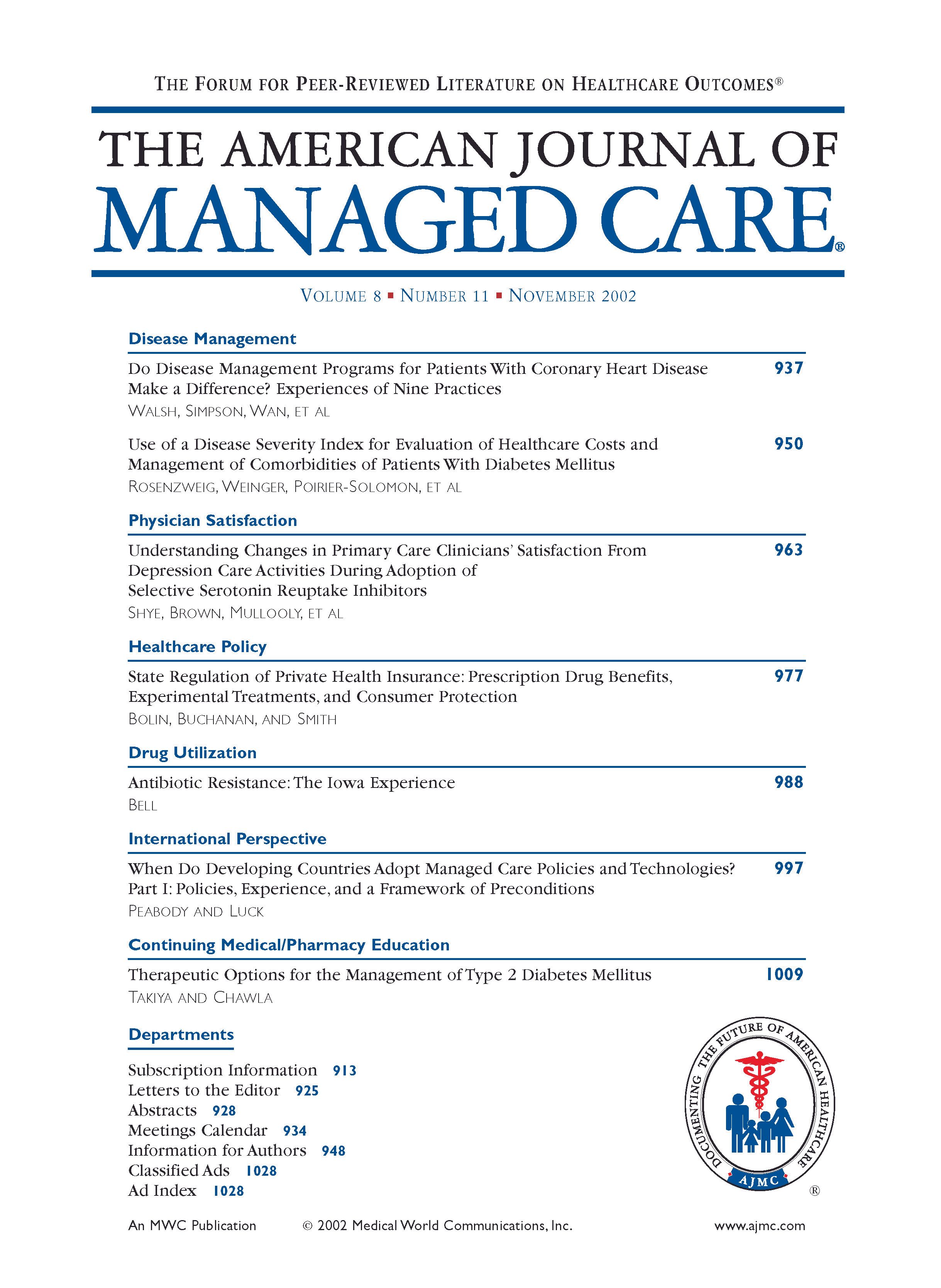- Center on Health Equity & Access
- Clinical
- Health Care Cost
- Health Care Delivery
- Insurance
- Policy
- Technology
- Value-Based Care
Correspondence regarding, "Potential Application of the National Kidney Foundation's Chronic Kidney Disease Guidelines in a Managed Care Setting"
TO THE EDITORS
We were pleased to see Thorp and Eastman1 have outlined a proposal to more aggressively and proactively implement the National Kidney Foundation Chronic Kidney Disease (CKD) Guidelines2 across a patient population. This approach is feasible in most health maintenance organization (HMO) and university settings, and should be applied more widely.
In fact, over the past year we have already put into practice such a system of screening for advanced chronic kidney disease. In our system, an HMO with a patient population greater than 200 000 with more than 400 dialysis patients, a central database contains information with regard to demographics, labs and diagnostic studies, and consultation. We periodically screen our population for patients with stage 3, 4, and 5 CKD, as well as patients with heavy proteinuria, who have not been referred to Nephrology. The Modification of Diet in Renal Disease formula for glomerular filtration rate estimation, which is based on easily accessible data including creatinine, gender, race and age,3 is used to stratify the stages of CKD. A nephrologist reviews the list, deleting patients with very advanced age, terminal illness, and transient conditions such as acute renal failure or pre-eclampsia. The primary care physician (PCP) is contacted by e-mail, and if agreeable, his/her patient is then contacted and consultation is scheduled.
So far this process has been successful. Patients with advanced CKD who for one reason or another had "fallen through the cracks," are receiving predialysis and transplant education, and important issues such as progression, anemia, and bone management are being addressed. Several patients have had fistulas placed. Up to this point, our focus has been mainly on recruiting the patients at greatest risk, with CKD stages 4-5, but we are also developing a system through which a nephrologist and renal pharmacist can identify and manage all patients with CKD stage 3, 4, and 5 in a large population.
A major problem with current clinical practice, in which only PCP's initiate consultation, is that there is significant variation in when patients are referred to a nephrologist. This can lead to inefficient utilization of resources. In our practice, with this variation in referral patterns, some patients with stage 1 CKD get referred and some patients do not get referred before reaching stage 5. In fact the NKF recommends referring at stage 4 and sometimes at stage 3. We plan to continue to both educate PCP's as to currently recommended practice (to decrease too—early referrals) as well as recruit unreferred patients with advanced disease. Standardizing the nephrology consultation process is a way to maximize effective care of renal disease in a population, and is an achievable and cost-effective goal. As Steinman says, "the devil is in the details."4 But the approach that Thorp advocates is an approach that actually works, in our experience thus far.
Alan Lau, MD
Ken Forbes
Kaiser Permanente, Hawaii Region
Am J Manag Care.
1. Thorp ML, Eastman L. Potential application of the National Kidney Foundation's Chronic Kidney Disease Guidelines in a managed care setting. 2004;10:417-422.
Am J Kidney Dis.
2. National Kidney Foundation. K/DOQI clinical practice guidelines for chronic kidney disease: evaluation, classification, and stratification. Feb 1, 2002;39(2 suppl 1):S1-S266.
Ann Intern Med.
3. Levey AS, Bosch JP, Lewis JB, Greene T, Rogers N, Roth D. A more accurate method to estimate glomerular filtration rate from serum creatinine: a new prediction equation. Modification of Diet in Renal Disease Study Group. 1999 Mar 16;130(6):461-470.
Am J Manag Care.
4. Steinman TL. Using guidelines to improve care of patients with chronic kidney disease. 2004;10:417-422.
IN REPLY
The kidney disease program described by Drs. Lee, Forbes, and Lau represents an integration of electronic medical records and clinical practice guidelines that will hopefully become the norm. Whether such a system will ultimately prove cost effective and improve patient outcomes remains unclear, but its feasibility is a reassuring first step.
Micah L. Thorp, DO, MPH
Milwaukie, Oregon

HEDIS Glycemic Goal Achieved Using Control-IQ Technology
December 22nd 2025A greater proportion of patients with type 1 diabetes who used automated insulin delivery systems vs multiple daily injections achieved the Healthcare Effectiveness Data and Information Set (HEDIS) glycemic measure.
Read More
Linking Data to Determine Risk for 30-Day Readmissions in Dementia
December 22nd 2025This study found that certain characteristics in linked electronic health record data across episodes of care can help identify patients with Alzheimer disease and related dementias at high risk of 30-day readmissions.
Read More
Performance of 2-Stage Health-Related Social Needs Screening Using Area-Level Measures
December 19th 2025Limiting health-related social needs screening to lower-income areas would reduce screening burdens; however, this study found a 2-stage screening approach based on geography to be suboptimal.
Read More
Impact of Medicaid Institution for Mental Diseases Exclusion on Serious Mental Illness Outcomes
December 17th 2025Medicaid’s Institution for Mental Diseases (IMD) rule bars federal funding for psychiatric facilities with more than 16 beds, but findings indicate that state waivers allowing treatment of serious mental illness in IMDs do not increase overall psychiatric hospitalizations.
Read More
Physician-Pharmacy Integration in Cancer Care: Pillars of Medically Integrated Pharmacy
December 16th 2025The foundation of medically integrated pharmacy includes 7 critical pillars. This commentary focuses on the benefits of 3 of those pillars: abandonment, adherence, and access/affordability.
Read More

